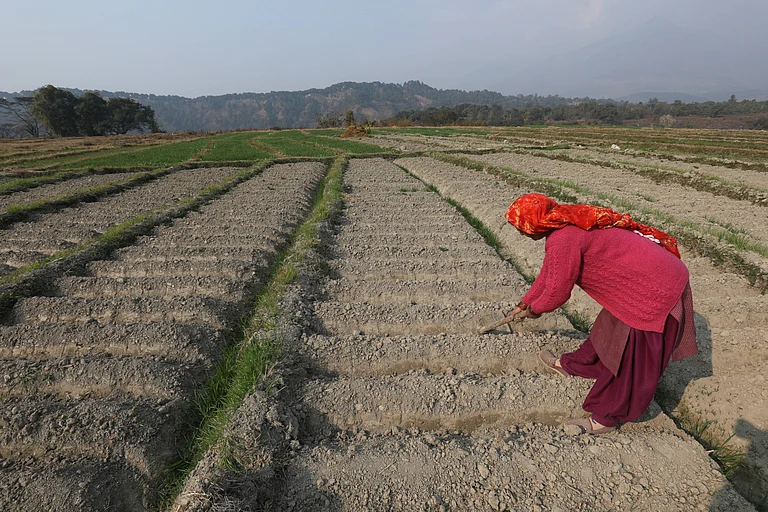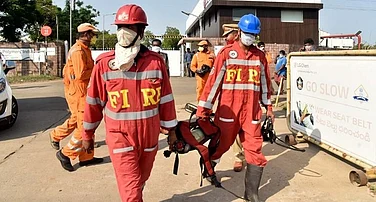Cheetahs Dhatri, Sasha, Uday, Daksha, Suraj, Tejas, and three cubs have died at Madhya Pradesh’s Kuno National Park – since March – less than a year since they were reintroduced with great vigour as part of India’s ambitious cheetah project. While cheetahs were declared extinct in India in 1952, the Indian government wanted to forge efforts to re-establish the species within its historical range. But as Project Cheetah unfolded from September 17, 2022, so did the challenges that surmounted one after the other, some of which experts had already warned of before it swung into action.
Kuno National Park in Madhya Pradesh’s Sheopur district received 20 cheetahs in two phases, eight from Namibia and 12 from South Africa, starting September 17, 2022. Since March, six of these adult cheetahs have died due to various reasons, including kidney failure and mating injuries.
In May, three of the four cubs born to a female Namibian cheetah had also succumbed to extreme heat. The remaining cub is being hand-raised for future wildling. The cubs were found to be weak, underweight and extremely dehydrated, park authorities said at the time.
While the action plan for India's reintroduction of the cheetahs, published in January last year, states that Kuno has a "suitable habitat and adequate prey base", the park has been under scrutiny ever since the deaths have come to the fore, with some conservationists questioning whether it provides enough prey, the risk of other predators and space constraints.
Choosing Kuno As Cheetahs’ Home
It was just days after India signed the MoU with Namibia on July 20 regarding the project, that the Rajasthan Forest Department on August 8 wrote to the National Tiger Conservation Authority (NTCA), entrusted by the Supreme Court in 2020 to run the Cheetah Project, proposing to host a few cheetahs in Mukundra in Rajasthan. But the Centre rejected it, the Indian Express reported.
Once again in 2023, the management of KNP wrote to the Union government to relocate some cheetahs out of KNP, as they “lack the manpower and infrastructure to support the felines in the wild,” the report said.
Several big cat experts have time and again warned that Kuno might not be the right fit for cheetahs, considering that it is a largely dry, deciduous forest land. Whereas the cheetahs from Africa are usually more adapted to the Savannahs of that continent.
“Such re-introduction projects are successful when the animal is being shifted to the same habitat. As was the case with rhinos, which started being translocated in 2008. They are adapted to swampy grassland habitat and they were re-introduced in a similar habit. But this isn’t the case with cheetahs in Kuno,” says Dr Girish Jathar, Deputy Director, Srushti Conservation Foundation.
Hence, when videos surfaced on April 2, of a cheetah strolling near Jhar Baroda village, about 20 km away from Kuno, experts were not surprised.
African cheetahs are also referred to as ‘nomads’, who move from one place to another alone. While some related male cheetahs might create a coalition, females prefer solitude. Asha and Pavan (previously called Oban), the Namibian cheetahs, who were released into the wild in March, snuck out of the park on multiple occasions. Wildlife experts are careful to point out that cheetahs wandering beyond the designated area were expected and warned of beforehand.
In a letter published in the journal Conservation Science and Practice on April 20, a group of scientists made a bunch of predictions about the cheetah project in India. “We therefore predict that the eight cheetahs will conduct extensive excursions outside the KNP during their exploration phase (Prediction 3), potentially coming into conflict with livestock farmers,” the authors wrote in their letter.
As per a Times of India report, the Project Cheetah team had tried to drive Oban back to Kuno by making a human wall and using vehicles to build a corridor to channel him into the park. However, the efforts did not pay off.
Asha also followed Oban outside park boundaries, into territorial forest areas just outside. On the evening of April 6, forest officials eventually “rescued” Oban and released him back in the Park, PTI reported, with some reports suggesting that the cheetahs had to be tranquilised for the same.
“Bringing them back each time may not be a viable strategy over the long term. It is unlikely to stop them from their need to explore their new home,” Bettina Wachter of Germany’s Leibniz Institute for Zoo and Wildlife Research had told The Wire.
The Cheetah Action Plan formulated by the government says that KNP can sustain up to 21 cheetahs currently and based on carrying capacity estimates, the potential cheetah habitat covering over 3,200 sq km in the larger Kuno landscape could provide a prey base for up to 36 cheetahs.
But, as cheetah experts Ravi Chellam, Arjun Gopalaswamy, and Leilei Karatbari had written in a paper in October 2022: “We anticipate that neither Kuno National Park, which is only 748 km2 in area, unfenced, harbouring about 500 feral cattle and surrounded by a forested landscape with 169 human settlements, nor the other landscapes considered1 are of the size and quality to permit self-sustaining and genetically viable cheetah populations.”
Fencing Cheetahs
Ahead of the commencement of the translocation project, experts from South Africa and Namibia, who helped with reintroducing cheetahs in India, recommended fencing their habitats to prevent poaching, habitat fragmentation and minimise human-animal conflict. But Indian experts were strongly against fencing.
“Our understanding is that regional networks of protected areas should merge into a national network of protected areas so that there is porosity for wildlife gene flow,” said Rajesh Gopal, chairman of the 11-member cheetah steering committee.
South African wildlife expert Vincent van der Merwe, who is closely involved with the project, had earlier told PTI that there has never been a successful reintroduction (of cheetahs) into an unfenced reserve in recorded history. It has been attempted 15 times in Africa and it failed every time. “We are not advocating that India must fence all of its cheetah reserves, we are saying that just fence two or three and create source reserves to top up sink reserves.”
He further said that the real dangers lie in injuries caused by hunting, potential fighting for territories and space with other cheetahs and encounters with other animals. “The worst mortalities are still to come,” he had said.
The Supreme Court too expressed concern about the deaths (at the time eight) and asked the Centre to consider shifting the felines to an alternate location. The court, citing expert opinions and news articles about the deaths, had said that the Kuno National Park may not be sufficient to accommodate so many cheetahs.
However, experts are also quick to point out that the project is a long-drawn affair and evaluating its success or failure at this stage would be a futile attempt. “The project is still very much in its infancy, and as this is the very first transcontinental wild large carnivore translocation in recent history. It understandably run into many challenges as the species explores a novel landscape, and new social contexts,” says Devavrat Pawar, a PhD candidate at the University of Wageningen. His master's research exclusively focussed on Kuno – Estimating the abundance of leopards in Kuno National Park.
Although it is unclear as to how the government will proceed with the project, and if it has identified other parks for the cheetahs, it is worth mentioning that there is fear among those who live nearby Kuno too. Radheshyam Yadav, a vendor selling snacks and tea on Sheopur-Shivpuri road, had told PTI, “What will happen to my small food outlet when the remaining four-five villages are shifted for the park? We are already affected financially because of the relocation of 25 villages for Kuno Park over the last 15 years.”
When the cheetahs stepped foot into our country, Prime Minister Narendra Modi called them our guests. But if it will be their home, will only be known in the years to come.


























